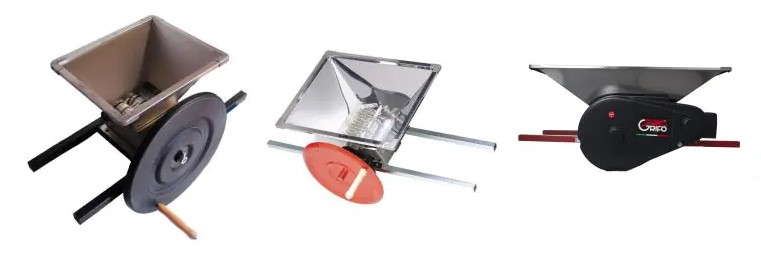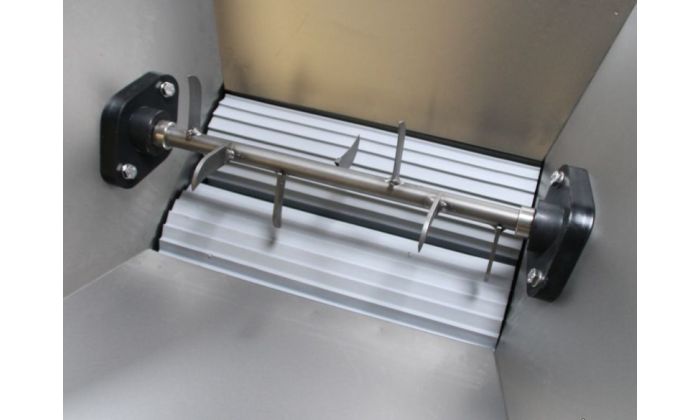How to choose an apple shredder.
To choose the right apple crusher, you first need to define the criteria linked to the use you will make of it and the volume you wish to process.
The role of the crusher in preparing fruit for pressing is essential. It is used to crush and shred fruits (such as apples, pears, quinces...) to transform them into a sort of coarse purée, often referred to as "pomace". This stage releases the juice contained in the fruit, making extraction much easier when the fruit is pressed. This is really the key stage between harvesting and pressing.
Without the use of a crusher, the yield of juice would be very poor. Optimum crushing is when the flesh is sufficiently broken up to release the juice, but enough structure remains to allow the liquid to pass through during pressing (coarse purée, pieces of around 5-10mm).
1. The different types of apple crushers
The manual crusher is hand-operated, often with toothed rollers or blades. It's economical, but requires physical effort. Its capacity is moderate, around 15-30kg per hour depending on the model and the energy supplied. The advantage is that it is compact, easy to transport and requires no electricity.
The electric shredder uses an electric motor to drive knives, rasps or rollers, depending on the model. Its capacity is medium, in the order of 100-300 kg per hour, depending on the model's power. The advantage over the manual shredder is that it's faster and requires less effort. It's ideal for regular family use.
The thermal shredder is ideal for very large volumes, for collective use, for orchards or cider mills. It requires no electricity, has a very high capacity (up to 500 kg per hour), is robust and suitable for intensive use.

2. Essential criteria for making your choice
Before making your choice, it's essential to consider the following points:
1.Quantity of apples to be shredded:
→ For a private individual with a small volume (20-50 kg/year), a small manual shredder may suffice.
→ For a larger volume (100 kg and over), an electric model is better.
→ For collective use or a cider mill, a thermal shredder will be more suitable.
2. Frequency of use:
→ Occasional: manual or simple electric.
→ Regular/intensive: powerful electric or thermal.
3. Hopper capacity: it all depends on the volume of apples to be shredded, but the larger it is, the less time you waste reloading.
4. Type of cut (knives, rasps, toothed rollers): toothed rollers are often more efficient for apples.
3. Construction materials
For small hoppers, shredders are generally made of food-grade plastic. They are lightweight, rust-proof and "entry-level" in price. However, they are less resistant to impact, less durable in the long term, and can crack over time.
Painted or galvanized steel apple crushers are stronger, more resistant to wear and impact, but can rust if the paint flakes or if the crusher has not been properly cleaned and dried.
Stainless steel apple crushers are the best quality, with excellent corrosion resistance, hygienic properties, easy cleaning and a longer lifespan. On the other hand, they are heavier and more expensive to buy. They should be seen as a long-term investment.
Blades and knives are generally made of steel or stainless steel, which ensures a long-lasting, wear-resistant cutting edge.

4. Care and maintenance of your shredder
After each use, the apple shredder should be rinsed thoroughly with water to remove pulp residues, especially around the blades, rollers and hopper. If possible, disassemble parts that are easy to remove for thorough cleaning.
Then wipe with a dry cloth and let the disposer air-dry before storing it in a dry place, especially if certain parts are made of non-stainless steel.
Every year, check the condition of the blades or rollers, sharpening them if possible (on certain models) or replacing them if they are worn. You can also lightly grease the shafts and bearings, especially on manual and toothed-roller shredders. Tighten screws and nuts if necessary, as vibrations can loosen them over time.
5. Operating tips for optimum performance
For maximum yield, we recommend that you sort your fruit carefully, and use apples that are ripe but not rotten. Fruit that is too hard will not produce much juice and will wear out the blades prematurely.
You can also wash your apples before crushing them, to remove dirt and residues.
If you have very large fruit (apples, quinces, pears), you can cut them in half before putting them through the crusher, to improve the regularity of the crushing (especially for manual models).
It is preferable to fill the hopper regularly, without overloading it, to avoid clogging. And make sure you obtain a coarse purée (5-10mm pieces) to get the most juice.
Enjoy!



